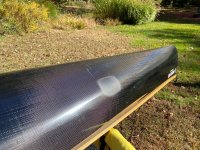Hi there,
Recently I’ve read up on certain alternative resins that can be used in any temperature, that are subsequently cured by the UV of sunlight, without the need to be mixed with any MEKP hardeners. One of the more commonly used ones is Solarez, but there are also some nontoxic eco-friendly resins like PhixDoctor that have no VOCs and apparently work very well for sealing dings and cracks in certain resin and epoxy coated watercraft. I have read that these products are really popular for surfboards and SUPs but I have not heard of them being used to repair cracks and chipped areas of canoes (though a kayaker once told me he uses it very successfully for his hull). I did talk with someone at PhixDoctor over the phone and he said their product would work great for the few cracks and small gouges in the vinylester resin of my Northstar Trillium.
I am curious to know if anyone here has used these kinds of products and how it went. I’d like to still go out on the water in these chilly autumn temperatures but want to make a few repairs first and don’t want to wait until the temps reach 70 degrees before I can do that with the traditional hardeners and resins...
Plus if I can do without a respirator and it’s better for the environment that would be wonderful.
Thanks and wishing you all well!
Recently I’ve read up on certain alternative resins that can be used in any temperature, that are subsequently cured by the UV of sunlight, without the need to be mixed with any MEKP hardeners. One of the more commonly used ones is Solarez, but there are also some nontoxic eco-friendly resins like PhixDoctor that have no VOCs and apparently work very well for sealing dings and cracks in certain resin and epoxy coated watercraft. I have read that these products are really popular for surfboards and SUPs but I have not heard of them being used to repair cracks and chipped areas of canoes (though a kayaker once told me he uses it very successfully for his hull). I did talk with someone at PhixDoctor over the phone and he said their product would work great for the few cracks and small gouges in the vinylester resin of my Northstar Trillium.
I am curious to know if anyone here has used these kinds of products and how it went. I’d like to still go out on the water in these chilly autumn temperatures but want to make a few repairs first and don’t want to wait until the temps reach 70 degrees before I can do that with the traditional hardeners and resins...
Plus if I can do without a respirator and it’s better for the environment that would be wonderful.
Thanks and wishing you all well!

